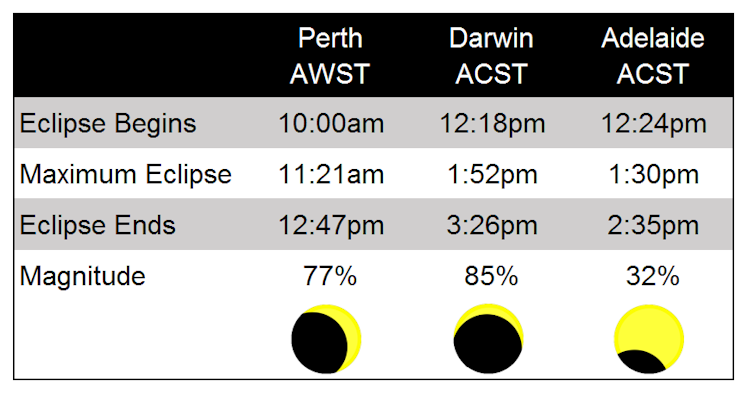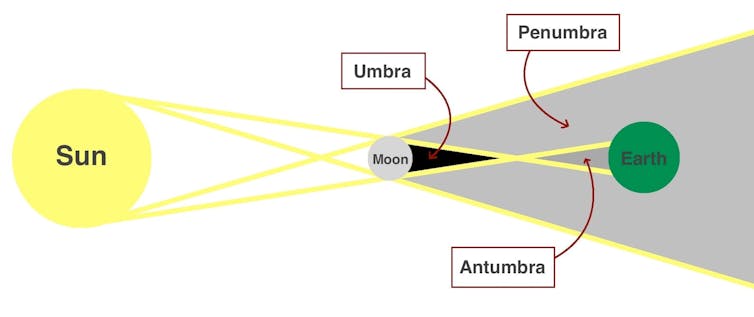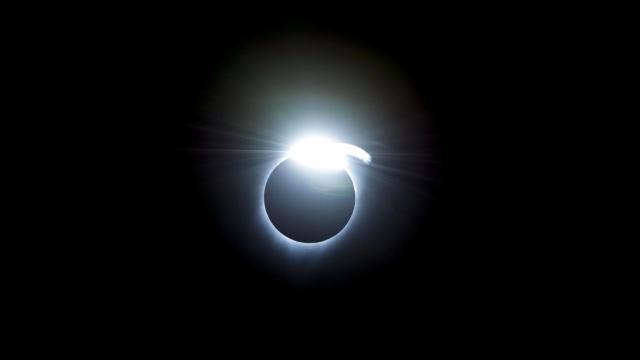On Thursday 20 April, the Ningaloo region of Western Australia will experience a total solar eclipse. Eclipse chasers from around the world are converging on the town of Exmouth in hopes of experiencing the profound awe of standing in the Moon’s shadow as it quickly races by.
Only a narrow path across Earth, which includes Exmouth and Barrow Island WA, eastern parts of East Timor and also parts of Papua in Indonesia, will experience totality – when the Moon fully blocks the light of the Sun.
Can we see the eclipse in other parts of Australia?
Across the rest of Australia, we will get a partial solar eclipse. Exactly how much of the Sun is covered by the Moon, as well as the timing of the eclipse, depends on your location. The farther away from the path of totality, the shallower the eclipse will be.
Comparing Australian capital cities, Darwin will experience the deepest partial eclipse – with 85% of the Sun’s diameter hidden by the Moon. For Hobart, located at the other end of the country from Ningaloo, just 13% of the Sun’s diameter will disappear behind the Moon.
During a partial eclipse, there is nothing to notice or clue you in that an eclipse might even be happening. Even when 90% or more of the Sun’s diameter is obscured by the Moon (known as the eclipse magnitude) you might only notice a very slight dimming of daylight. More so, the colours and light around you may look a little strange.
The local circumstances for the eclipse across Australian capital cities are provided in the tables below. To find out what’s happening in your location, you can use timeanddate.com
or an online Google map created by French amateur astronomer Xavier Jubier (note that all times will need to be converted from UTC).


What is a ‘hybrid’ eclipse?
Technically, this solar eclipse is a special type, known as a hybrid eclipse. It begins over the Indian Ocean as an annular eclipse, where the Moon is slightly too small to completely block the Sun and a ring of sunlight shines out from around the dark Moon. This happens when the Moon’s antumbral shadow hits Earth (see diagram).

The Conversation
By the time the Moon’s shadow reaches land, it will become a total eclipse – the Moon now appears large enough to completely block the Sun, and it is the Moon’s umbral shadow that falls on Earth.
It’s incredible that such an eclipse occurs, because it means Earth is situated in the sweet spot between the umbral and antumbral shadows. Parts of Earth are in the umbral shadow, while the curvature of the planet is enough to make other places sit slightly farther away, so that the antumbral shadow falls there.
Don’t forget about eye safety!
Most importantly, a solar eclipse requires special precautions to observe it safely. Never look directly at the Sun because it can cause serious and permanent eye damage.
You can observe a solar eclipse safely by protecting your eyes with certified eclipse glasses or view the Sun indirectly by creating a pinhole camera to project a tiny image of the Sun onto a wall, the ground or a piece of paper.
Just remember this is a projection technique – do not look at the Sun through any pinholes.
Observing the totality
For those fortunate to be in Exmouth, the eclipse will begin at 10:04am, and totality will occur at 11:30am, producing an eerie twilight. For just 58 seconds, eclipse observers will be plunged into the Moon’s shadow for an awe-inspiring experience.
What’s most amazing is totality reveals a part of the Sun we don’t normally see. The Sun’s magnificent corona – its outer atmosphere – extends millions of kilometres into space and can be seen dancing and shimmering.
It’s also possible to see planets and bright stars during totality, if you can tear your gaze away from the shimmering corona. There are currently four planets in our daytime sky and all will be revealed – Saturn and Jupiter sitting above the Sun, with faint Mercury and bright Venus below it.
That brief moment of totality, when the Sun is completely covered by the Moon, is the only time to safely watch the eclipse directly. All too quickly, the Moon will move on and it will be time to shield your eyes again.
Australia, get ready for more
Remarkably, this eclipse is the first of five total solar eclipses to occur over the next 15 years in Australia.
What’s more, many of the upcoming eclipses will see totality pass over highly populated areas:
- July 22 2028 – totality will cross from the Kimberley, WA, through the Northern Territory, southwest Queensland, New South Wales, and pass directly over Sydney.
- Nov 25 2030 – totality will occur across South Australia, northwest NSW and southern QLD.
- Jul 13 2037 – totality will cross southern WA, southern NT, western QLD, passing directly over Brisbane and the Gold Coast.
- Dec 26 2038 – totality occurs over central WA, SA, and along the NSW/Victoria border.
For some Australians, there will be no need to travel the world to experience totality, when you have the chance to see it from your own backyard.![]()
Tanya Hill, Senior Curator (Astronomy), Museums Victoria and Honorary Fellow at University of Melbourne, Museums Victoria
This article is republished from The Conversation under a Creative Commons license. Read the original article.

Leave a Reply
You must be logged in to post a comment.